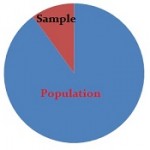Sampling > Haphazard Sampling
What is Haphazard Sampling?
 Haphazard sampling is where you try to create a random sample by haphazardly choosing items in order to try and recreate true randomness. It doesn’t usually work, because of selection bias: where you knowingly or unknowingly create unrepresentative samples. In order to create a true random selection, you need to use one of the tried and testing random selection methods, like simple random sampling.
Haphazard sampling is where you try to create a random sample by haphazardly choosing items in order to try and recreate true randomness. It doesn’t usually work, because of selection bias: where you knowingly or unknowingly create unrepresentative samples. In order to create a true random selection, you need to use one of the tried and testing random selection methods, like simple random sampling.
Even if you try to choose items without any bias or reason for including (or excluding) items, haphazard samples nearly always result in a sample that looks a lot different from a random sample. Therefore, the results from your test or experiment will have unpredictable errors and most likely, invalid results.
Sometimes haphazard sampling is used because it is cheaper than other sampling methods or because you aren’t able to meet random sampling requirements for technical reasons (like lack of access to computer software). If you must use haphazard sampling, you can raise the odds of a successful sample by:
- Ensuring your sample selections are independent of each other. In other words, select one item and then randomly choose another. Don’t choose two As or two Bs because it seems easier.
- Ensure that each item has an equal probability of being selected. Person A should have exactly the same odds of being selected as person B, C or Z.
- Use larger sample sizes. Research has shown that increasing your sample size can reduce haphazard selection bias.
This sounds easy, but in practice your choices can be influenced by factors you aren’t aware of. For example, you might unconsciously choose a name because of the way a name looks, or you might show a hidden gender preference. You might subconsciously exclude an item and include another because you know one item would be easier to locate than another. It’s not possible to identify and eliminate all your biases, which is why random sampling is preferred.
Reference:
Hall, T., T. Herron, B. Pierce, and T. Witt. 2001. The effectiveness of increasing sample size to mitigate the influence
of population characteristics in haphazard sampling. Auditing: A Journal of Practice & Theory 20 (1): 169–185